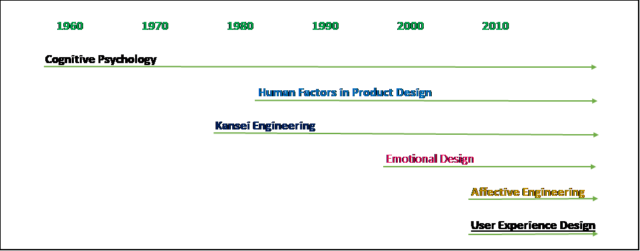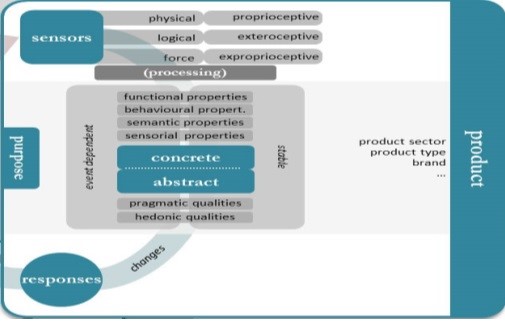UX, known as User Experience in Product Design Perspectives
March 2018, Written by:
Dr. Khristian E.N. Soebandrija, BSIE, MM
Binus ASO School of Engineering (BASE), Binus University
UX, known as User Experience, by perception has been associated with software development. Conversely, within Binus ASO School of Engineering (BASE, Binus University) perspectives, in particularly in Product Design Engineering (PDE) program; this perception is elaborated in innovated spectrum. The mentioned spectrum is intended to spectacle product design engineers the frontier of the new competencies far beyond classical form-giving, in term of user experience (UX) dimensions.
Bongard-Blanchy and Bouchard (2015) indicate user UX dimensions that potentially impact how users’ experience products. These dimensions are brought together from theories of Cognitive Science, models of Human-Computer Interaction and findings from Design Research. They are presented under four categories: dimensions of human perception, dimensions of products, dimensions of the context of use and the temporal dimension. In the final part, the identified dimensions are connected into a schema, illustrating their interplay and therefore the journey of UX between a user and a product, in a certain context over a certain time.
Subsequently, Bongard-Blanchy and Bouchard (2015) elaborate the Evolution of research domains related to the UX of Products, as illustrated in Figure 1.

Figure 1 Evolution of research domains related to the UX of Products
Figure 1, illustrates and elaborates several evolution of research domains related to the UX of Products, as indicated by Bongard-Blanchy and Bouchard (2015).
First, researchers in cognitive psychology were the first to look at the human perception of objects (Gibson 1986). With the arrival of personal computers, the domain of Human-Computer Interaction emerged as a means to improve the usability of graphical interfaces (Forlizzi and Ford 2000).
Second, in the Product Design domain, the study of human factors gained importance for the same objective: that of optimizing usability (Norman 1988; Green and Jordan 1999).
Third, researchers of “Kansei Engineering” (Tomico et al. 2008) in Asia were the first to
anticipate the emotions, sensations and semantics conveyed by a Product Design.
Fourth, in the Western world, the start of the new century saw the advent of research into “Emotional Design”; the study of the emotional value of products (Desmet 2002; Norman 2004).
Fourth, furthermore researchers of “Affective Engineering” investigate the sensorial experience evoked by materials and textures (Salvia et al. 2010).
Fifth, while UX is still commonly associated with the realm of Human-Computer Interaction, other domains such as Product or Service Design integrate the findings of these various domains under the paradigm of UX Design / Experience Design (Hassenzahl 2011).

Figure 2 Schema of dimension of the User-Product Experience
Figure 2, illustrates and elaborates Schema of dimension of the User-Product Experience, as indicated by Bongard-Blanchy and Bouchard (2015). Through this literature review, theyhave sought to demonstrate how UX results from the interplay of a wide range of concrete (form, colour, semantic, function) and abstract (affective and sensorial quality, semantic quality, aesthetic quality) product dimensions, together with their perception by the target user, the context in which s/he encounters the product and the temporality of the experience.
The mentioned Figure 2, is further illustrated in detail in Figure 3 and 4, in term of User and Product, respectively.

Figure 3 Schema of dimension of the USER Experience
 Figure 4 Schema of dimension of the PRODUCT Experience
Figure 4 Schema of dimension of the PRODUCT Experience

Figure 5 Dimensions of conceptual design (top) and design evaluation (bottom) when designing for UX.
Figure 5, illustrates and elaborates Dimensions of conceptual design (top) and design evaluation (bottom) when designing for UX, as indicated by Bongard-Blanchy and Bouchard (2015).
Subsequently, Bongard-Blanchy and Bouchard (2015) indicates that bowadays Product Designers has challenges to espouse a holistic view of UX vis à vis conceptual design and design evaluation. That challenges construe, conceptual design should alwaysaim congruence between identified (and potentially evolving) user goals and the product purpose. The Product Designer delineates function, semantic, sensorial and behavioural properties with regard to their hedonic and pragmatic quality. To validate and improve the designed experience, concepts and prototypes should then be recurrently evaluated through user tests. These evaluations authenticate which pragmatic and hedonic qualities the user really attributes to the designed product.
To conclude, by synthetizing the elaboration and discussion of prior paragraphs, there are beneficial aspect in term of UX Dimensions. Precisely, within Binus ASO School of Engineering (BASE, Binus University) perspectives, in particularly in Product Design Engineering (PDE) program; this perception is elaborated in innovated spectrum. The mentioned spectrum is intended to spectacle product design engineers the frontier of the new competencies far beyond classical form-giving, in term of user experience (UX) dimensions.
REFERENCES
Bongard-Blanchy, K., Bouchard, C. (2015). Dimensions of User Experience - from the Product Design Perspective. Journal d’Interaction Personne-Système.
Desmet, P. 2002. “Designing Emotions”. PhD thesis. TU Delft.
Forlizzi, J., and Ford, S. (2000). “The Building Blocks of Experience: An Early Framework for InteractionDesigners.” In Symposium on Designing Interactive Systems, 419–423. New York, New York, USA.
Gibson, J. J. (1986). The Ecological Approach to Visual Perception. Tayler & F. New York, New York, USA:Psychology Press.
Green, W., Jordan, P. W. (1999). Human Factors in Product Design: Current Practice and Future Trends. London: Tayler and Francis.
Hassenzahl, M. (2011). “UX and Experience Design.” In Encyclopedia of Human-Computer Interaction, edited by Mads Soegaard and Rikke Friis Dam. Aarhus, Denmark: The Interaction Design Foundation.
http://www.interactiondesign.org/encyclopedia/user_experience_and_experience_design.html.
Norman, D. A. (2004). The Design of Everyday Things. New York: Basic Books.
Norman, D. A. (2004). Emotional Design. Cambridge, MA: Basic Books.
Salvia, G., Rognoli, V., Malvoni, E., and Levi, M. (2010). “The Objectivity of Users’ Emotional Experience with Textiles Biological and Mechanical Tests for the Prediction of the Sensorial Profile of Fabrics.” In Seventh International Conference on Design and Emotion, 1–12. Chicago, IL.
Tomico, O., Mizutani, N., Levy, P., Takahiro, Y., and Cho, Y. (2008). “Kansei Physiological Measurements and Constructivist Psychological Explorations for Approaching User Subjective Experience During and After product Usage.” In International Design Conference - Design, 529-536. Dubrovnik.

Comments :